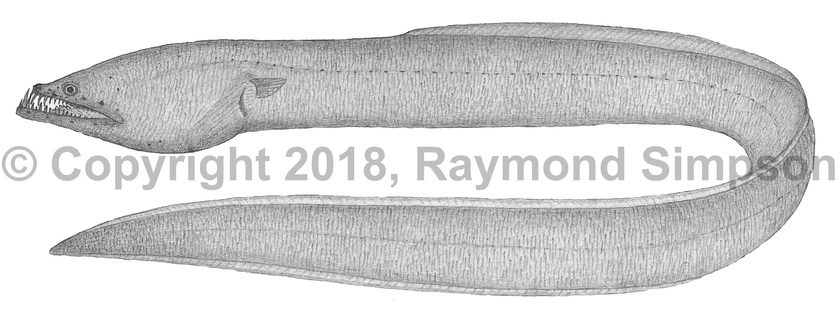
Common Name
Tusky Eel
Year Described
Böhlke, 1956
Identification
Vertebral formula: 20-26 predorsal, 53-56 preanal, 110-115 total
Body elongated but stout, cylindrical forward and laterally compressed rearward. Trunk about equal to caudal region. Throat broadens behind jaw and narrows at pectoral fin. Forehead noticeably concave. Snout short, narrowing anterior to eye, and slightly hooked upward.* Lower jaw long and slender; projects beyond upper. Anterior nostril a short tube. Posterior nostril a tube below eye. Teeth are obvious and well developed. Teeth near front of jaw enlarged and projecting well outside mouth when mouth is closed. Upper jaw with two rows of teeth. Lower jaw with two rows of teeth. Intermaxillary with a row of large fangs and a median row of small teeth. A single median row of teeth. Gill slit on side and anterior to pectoral base. Finfolds low but well developed. Dorsal and anal fins not confluent; tail tip a finless point (Ophichthinae). Dorsal fin origin behind pectoral tip. Pectoral fins present, pointed, and moderately developed. Eye small; distinctly closer to snout tip than end of upper jaw. Body and head pores minute. Tongue fleshy and modified into a lure.
Color
Body tan to dirty brown with scattered brown spots on the dorsum. Skin grooves darker. Fins lighter with a dark margin.
Size
Maximum size to 81.5cm TL. Mature males smaller on average.
Habitat
Taken on soft bottoms from 1-91m.
Range
The Gulf of Mexico to northern South America, including the Caribbean Sea.
References
McEachran, J.D. and J.D. Fechhelm. 1998. Fishes of the Gulf of Mexico. Volume 1: Myxiniformes to Gasterosteiformes. University of Texas Press, Austin. i-viii + 1-1112.